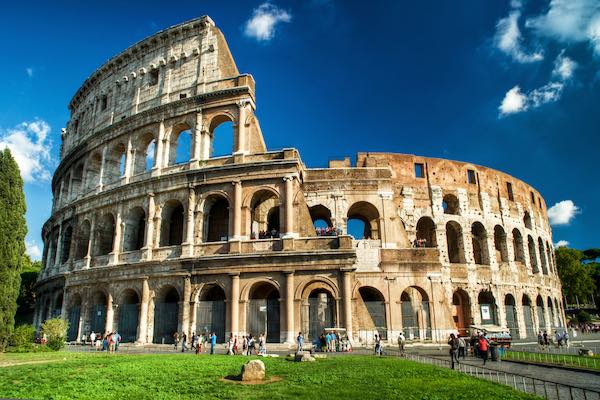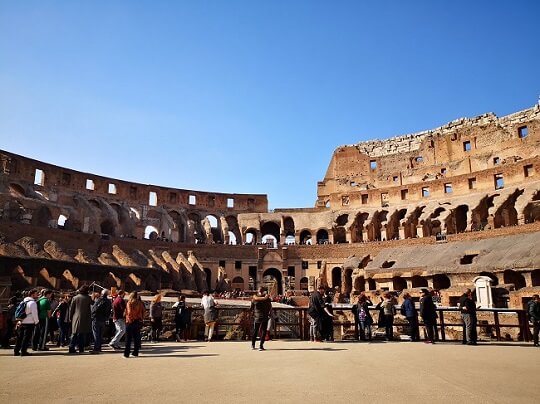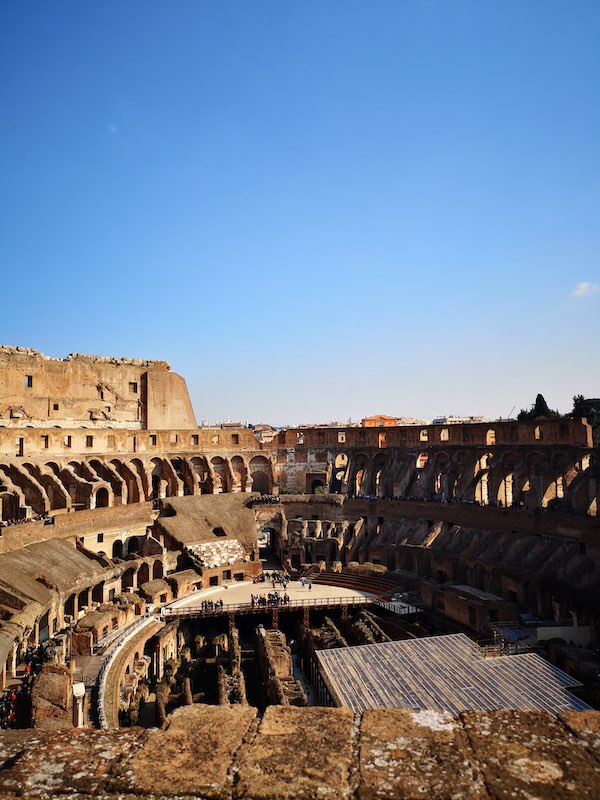Roman entertainment: ancient roman games, sports and shows. All you need to know
One of the most famous Latin sayings is ‘Panem at Circenses,’ commonly translated as bread and circuses.
We owe this expression to ancient Roman poet Juvenal.
In the II century AD, he used it to summarise the two things a ruler needed to conquer the heart and loyalty of the Roman people: the essentials (bread) and entertainment.

Indeed, many ancient sources told us that the Romans attached great importance to their games and shows.
Going to the theater and the stadium were among the most popular leisure activities in ancient Rome.
Spectators from all walks of life loved live shows and Emperors quickly understood the prestige and power that could come from giving people the entertainment they craved.
Many of ancient Rome’s most famous archaeological ruins bear witness of this significance.
The Colosseum (a theater), the Circus Maximus (a stadium) and Marcellus’ Theater are all beautiful examples of places for public performances.
Ancient Roman games and shows are fascinating. Today we are going to look at the most popular in Republican and Imperial times.
What did the Romans like to do for entertainment?
When we talk about entertainment in Ancient Rome, we must distinguish between private leisure time and public forms of entertainment such as games, spectator sports and shows.
We have talked here >>> about Ancient Roman leisure pastimes and games.
In this article, we are going to instead talk about public entertainment in Rome.
The most popular forms of spectator games and show entertainment in ancient Rome were:
Going to Ludi – Games
By far, the most popular form of Roman entertainment were spectator games, that the Romans called Ludi.
Roman games were spectacular, popular events that attracted large crowds.
They usually happened over the course of a full day or several days in a row, in a way not dissimilar to our Olympics or multi-day sports events, and they involved several types of shows including races (Ludi circenses) and shows (see below).
Ludi / Roman games usually took place in special occasions: some were annual occurrences, and some were ad hoc festivities in honor or an Emperor or specific religious occurrences.
Annual festivities were usually attached to religious celebrations of Roman Gods.
The list of annual roman games includes: Ludi Megalenses (for the Goddess Magna Mater), , Ludi Ceriales, Ludi Florales, Ludi Apollinares (for the god Apollo), Ludi Romani, Ludi Augustales, Ludi Plebeii.
Examples of ah hoc games are Ludi Capitolini and Ludi Decennales.

See Sport Performances – one of the most popular types of Roman shows
Sport performances the most beloved part of ancient Roman games.
Among the most popular were those that involved speed, strength and elements of danger.
A great example of poplar sport in Rome is chariot races (see below).
Romans also inherited from ancient Greek sports such as athletics, running and wrestling. However, these type of sports never grew to great popularity.
The Romans disliked the showcase of sparsely clothed bodies and preferred spectacular sport shows, which they felt athletes in the traditional terms did not provide.
Go to Theatrical performances
The Romans inherited their love for theater from the Greeks, who produced some of the most significant writers of comedies and tragedies in the history of western society.
Theatrical performances were a popular for of roman entertainment and often took places on the same occasion of games, and in the same spaces.
The most common form of theatrical shows with actors were comedies, tragedies and mime.

Most popular games and shows in ancient Rome
Roman Gladiator games
Roman gladiator games are probably the best known of all forms of entertainment in Ancient Rome.
We know about them from ancient sources but they also picqued the attention of many generations, attracted by the showcase of strength and violence they involved.
Due to this mystique surrounding Roman gladiators and their games, it is not always possible to distinguish reality from myth.
However, we have sufficient reliable sources for historians to know some certain gladiator facts.
Gladiator combats were shows where professionals would fight in front of a crowd.
You can read here >>> all about Roman gladiators

Gladiator fights involved different types of weapons that depended on the men’s physical built, muscle mass and skill.
They included short swords (gladius), longer swords spires and the gladiator equipment seems to have included shields and helmets.
Gladiators were often slaves and they belonged to their trainers.
Gladiator owners would put them through training school and would pay for their maintenance, also taking care of their health in case of injuries.
Like professional athletes, a victorious gladiator would be worth a lot of money to his owner: a little like a model day bull fighter, a good gladiator could keep fighting over and over again giving his trainer significant income and glory.
Good gladiators were also loved by the crowds who loved nothing better than a good show. Famous gladiators were celebrities.
Because of this, gladiator fights were not always to the death.
Gladiator games happened in the Colosseum and lasted until the fall of the Roman empire. The last gladiator game happened in 404 A.D.
Gladiators fights were extremely violent: we have memory of this thanks to the Roman Writer Seneca who, interestingly, didn’t approve of them.
In line with his adherence to Stoic philosophy, he criticised the excitement caused by gladiator in the Roman arena and didn’t consider fights a good way for people of ancient Rome to entertain themselves.
Chariot racing – one of the most popular sport events in Ancient Rome
Romans adored spectators sports and had a particular passion for those that involved speed, violence and a high level of risk for the participants.

Among the favorite sports, we find chariot racing, the king of ancient Roman sports.
The races happened in designated spaces called circuses, two of which are still well visible in Rome: the Circus Maximum and the Stadium of Domitian, now known as Piazza Navona.
The chariot stadium was a large, oblong structure with two metae at the two ends.
Participants were to race around them a certain number of times, if victorious, would be rewarded with honor and glory.
Chariot races happened with bigas, trigas and quadrigas and were extremely dangerous.
It was very common for chariots to capsize and for the horses and men to be run over by the other participants.
Fun fact: a fun virtual experience allows us to get a sense of what a chariot race in Ancient Rome would have been like. The Circus Maximus Experience is a special tour of the Circus that uses augmented reality goggles to show how the circus would have been and to recreate a virtual race. It is very well made and interesting for adults and kids. You can learn about the Circus Maximus Experience here.
Hunting games – venationes
A popular and unique time of show in ancient times was a hunt.
The Latin terms for hunt/ hunting is venatio and the plural venationes is the term used for hunting games.

Animal hunts showed in Roman amphitheaters such as the Colosseum and took several forms: in some case, they saw animal flights and in others you would have people and animals facing each other.
Venationes were violent and dangerous but much beloved.
It is reported that emperors went to all lengths to get animals that would impress and surprise the crowds and we have depictions of animals fights involving wolves, large felines and even bear.
The Colosseum is the most famous theater for venationes: the wild animals were kept below the main arena and lifted by manual lifts operated by slaves.
The appearance of the beast was a showstopper that never failed to impress the spectators.
You can learn more about the Colosseum and where animals were kept in our >>> fun facts about the Roman Colosseum.
Lusus Troiae – Game of Troy
Lusus Troie was an important equestrian event that attracted large crowds.
The name of the game means ‘Game of Troy’ and we find information about it in the Aeneid, where Virgil gives a great description of it.
According to the author, Lusus Troiae was performed in the occasion of public events such as a public funeral, the inauguration of a new temple or after a triumphal procession.
The event comprised of a series of equestrian exercises carried out by groups of twelve riders (turmae) and showcased the war skills and the horseback riding ability of roman young men.
Virgil mentions the game as part of the ceremonies linked to the death of Anchises, the father of Aeneas according to Roman mythology, but historians believe it was popular under Julius Caesar, who seems to have revived it during the last years of the Roman Republic.
Archeologists believe the players of this game were the young sons of the most important Roman families who used this occasion also as a sort of coming out to society.
Naumachia – spectacular naval battles
The word Naumachia comes from Greek and meaning naval battle.
In Rome, the term was used to define a spectacular type of show that reenacted historical naval victory in front of the eyes of an admiring audience.
Naval battles were large and complicated shows to set up. The show foresaw flooding a designated area and then equip it with ships, weapons and performers.
The cost of these shows was prohibited and historians believe they weren’t overly common.
Ancient sources tells us that naumachiae happened inside the colosseum.
The arena area would be flooded and the battle would happen in front of the over 50.000 spectators the colosseum could host.
However, despite the many representations that later painted gave of the flooded colosseum, archaeologists believe the amphitheater only occasionally hosted them.
Probably the Colosseum only ever hosted one Naumachia, performed for its inauguration.
Capital Executions as a form of Roman entertainment
Executions were public events in Rome and Romans went to them as they went to a show.
A day at the Colosseum involved many different spectators events and public executions were one of them.
Life sentenced in Ancient Rome were often carried out in cruel and spectacular manners, so that they could act as a strong deterrent and a warning for anyone thinking of breaking the law or challenge current rulers.
Where did the Romans go for entertainment – Popular locations for Romand games and shows
Rome has several public spaces devoted to entertainment:
The Colosseum – this is the most famous of all ancient Roman theatres and used to hold gladiator fights, theatrical performances, exceptions and possibly naval battles.
Marcellus’ Theater, an ancient theater in Rome, also devoted to theatrics representations.
Outside of the city of Rome, there are many examples of smaller amphitheatres hosting similar games in several parts of the Roman Empire
The Circus Maximus and the Stadium of Domitian (now Piazza Navona), the chariot race stadiums
Other spaces where the Romans could entertain themselves were:
- Campus Martius, popular for running and ball games
- The Tiber River, popular for swimming
- The Roman baths, popular for swimming, gymnasium sports, board games, and reading
Private forms of Roman entertainment
So far, we have discusses the most popular forms of public entertainment in Ancient Rome. However, the Romans had many other ways to spend their free time.
Popular leisure activities in Rome were ball games, board games, dice games, going to the baths, throwing dinner parties and music.
You can learn here >>> all about how romans enjoyed their leisure time
I hope you enjoyed this quick overview of popular forms of Roman entertainment and it helped you put in context some of the most significant Rome attractions in Rome and beyond.
